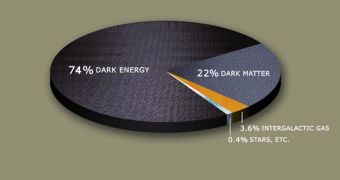American investigators have just been granted approval to construct a telescope that will be able to peer back as much as 10 billion years into the history of the Universe, and determine how dark energy shaped it. The findings could help explain how the Cosmos is set up.
There are numerous researchers who believe that dark energy is a force that was literally turned on some 7 billion years ago, or about the same time when the Universe was only half of its current age.
At that time, this form of energy began augmenting inflation, and started driving galaxies away from each other at ever-increasing speeds. The phenomenon continues even now, as evidenced by studies of distant galaxies and how they move.
Astronomers at the University of California in Berkeley (UCB) say that the new telescope project will allow them and their colleagues more insight into the distant past. This could lead to the creation of the most detailed maps of the Universe ever created.
The researchers could also understand how dark energy shaped the evolution, shape, size and mass of the Cosmos, something that it proving increasingly difficult to accomplish at this point. About 35 research groups, organizations and institutions will be involved in this endeavor.
“This is a project that people have been screaming to do for years. The universe itself is really unmapped today,” explains David Schlegel, an astronomer at the US Department of Energy's (DOE) Lawrence Berkeley National Laboratory (Berkeley Lab).
The Sloan Digital Sky Survey is one of the ongoing initiatives to map the entire sky. It has been at work for 10 years, but the data the planned survey will produce will allow experts to create a map up to 10 times larger.
The US National Science Foundation (NSF) and the National Optical Astronomy Observatory (NOAO) need to approve the project as well, but experts are positive that there will be no problems with this.
According to the research team, the project is called BigBOSS, which stands for Big Baryon Oscillation Spectroscopic Survey. The survey will use an observatory located outside Kitt Peak, Tucson, Arizona, where the 4-meter Mayall Telescope is located.
If the international venture succeeds, then we could gain access to a huge array of data about how the Universe is set up, and why. Taking a sustained, collaborative approach to studying the Cosmos is the only way to keep track of this vast space within a single life time, Daily Galaxy reports.

 14 DAY TRIAL //
14 DAY TRIAL //